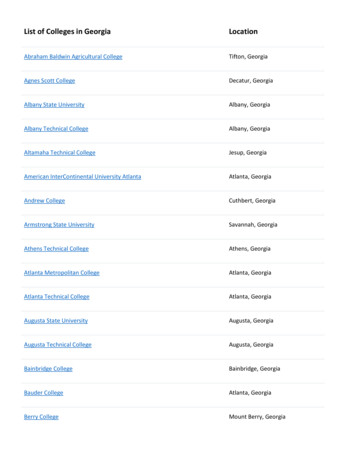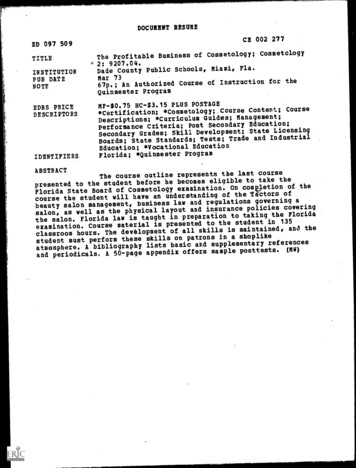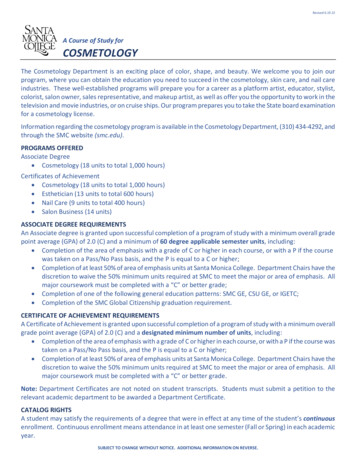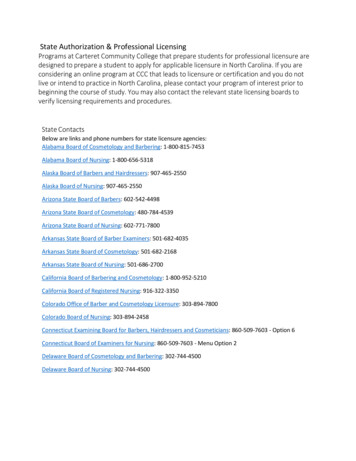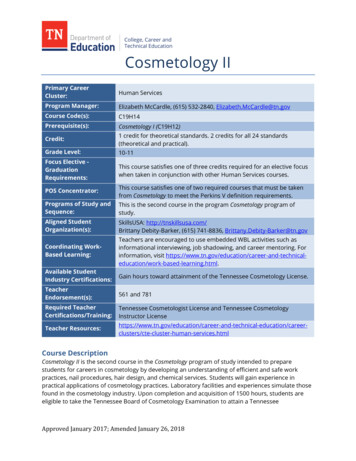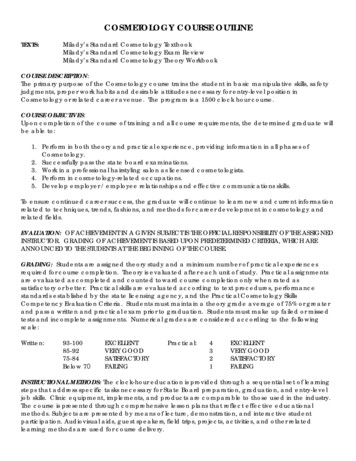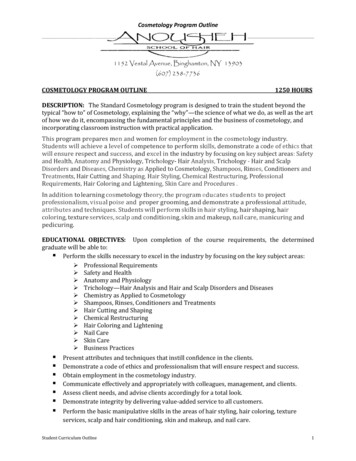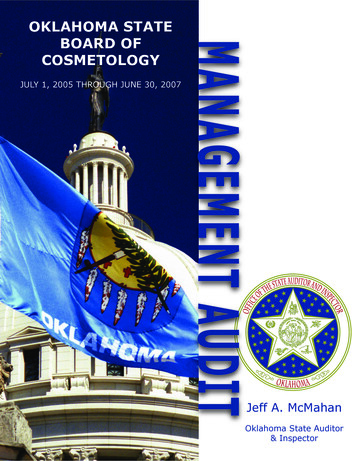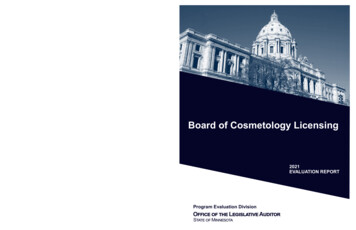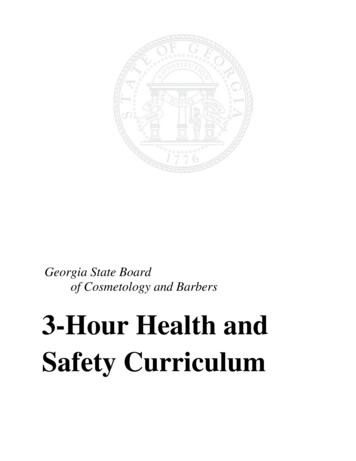
Transcription
Georgia State Boardof Cosmetology and Barbers3-Hour Health andSafety Curriculum
Georgia State Board of Cosmetology and BarbersTemporary Health and Safety Curriculum for July 1 – December 31, 2015Please visit the Board’s website for current and proposed ruleswith the passage of House Bill 314www.sos.ga.gov/plb/cosmetologyCopyright October 2002-2015 State of GeorgiaAll rights reserved. No part of this manual maybe reproduced or transmitted in any form or by any means,electronic or mechanical, including photocopying, recording,or by any information storage and retrieval system,without written permission from theTechnical College System of Georgia.Developed for the Georgia State Board of Cosmetologyand the Georgia State Barber Boardby theTechnical College System of GeorgiaFormerly the Georgia Department of Technical and Adult Education (DTAE)Publication #C121002Published December 2002Revised November 2008
Page 1 of 92GEORGIA TCSG HEALTH AND SAFETY—3 HRS.COURSE TABLE OF CONTENTSSECTION 1: SKIN, DISEASES, DISORDERSxxAnatomy and Histology of the Skino Nerves of the Skino Glands of the Skino Nourishment of the Skino Functions of the Skino TerminologyDiseases and Disorderso Skin Conditions/Descriptionso Nail Diseases/Disorderso Hair Disease/Disorderso Skin Conditions/DescriptionsSECTION 2: BLOODBORNE PATHOGENSxxxxxxxxWhat are Bloodborne Pathogens?Hepatitis B Virus (HBV)Human Immunodeficiency Virus (HIV)Signs and SymptomsTransmissionTransmission RoutesRisk Factors and BehaviorsPersonal Protective EquipmentSECTION 3: DECONTAMINATION & STERILIZATIONxxxCommon QuestionsHIVPrecautionsSECTION 4: DECONTAMINATION AND INFECTION CONTROLxxxxProfessional Salon EnvironmentSafety PrecautionsMaterial Safety Data Sheet (M.S.D.S.)Organizing an M.S.D.S. NotebookSECTION 5: GEORGIA STATE BOARD OF COSMETOLOGY SANITARY REGULATIONS FOR SALONSAND SCHOOLSSECTION 6: APPENDIX A GEORGIA STATE BOARD OF COSMETOLOGY GLOSSARY OF LEGALDEFINITIONS
Page 2 of 92Georgia Department of Technicaland Adult EducationSkin, Diseases,Disorders
Page 3 of 92Copyright October 2002by Georgia Department of Technical and Adult Education.All rights reserved. No part of this manual maybe reproduced or transmitted in any form or by any means,electronic or mechanical, including photocopying, recording,or by any information storage and retrieval system,without written permission from Georgia Department ofTechnical and Adult Education.Published December 2002(C121002)Skin, Diseases, DisordersGeorgia Department of Technical and Adult Educationiii
Page 4 of 92Table of ContentsSkin, Diseases, Disorders . 1Introduction . 1Objectives . 2Anatomy and Histology of the Skin . 3Nerves of the Skin . 5Glands of the Skin . 5Nourishment of the Skin . 6Functions of the Skin . 6Terminology . 7Diseases and Disorders . 11Skin Conditions /Descriptions . 12Skin, Diseases, DisordersGeorgia Department of Technical and Adult Educationv
Page 5 of 92Skin, Diseases, DisordersIntroductionThe flexible, waterproof, tough protective covering known as the skin is thelargest organ in the body both by weight and surface area. Skin accounts forapproximately 16% of the body’s weight.Healthy skin has a fine texture that is slightly moist, soft, and flexible.Varying in thickness, the skin is thinnest on the eyelids and thickest on thepalms and soles. A callous can be caused by continuous friction on any partof the skin.The skin has appendages that include the hair, sweat and oil glands, and thenails. Composed of the substance known as keratin, this protein gives theskin its protective ability. The skin is slightly acidic in pH, which enables goodimmunity responses to intruding organisms. Normally the skin separates theinternal environment from the external. However skin diseases and infectionscan invade that barrier. For this reason, a thorough understanding of thehistology of the skin and its diseases and disorders is needed for a betterposition to give clients professional advice.Skin, Diseases, DisordersGeorgia Department of Technical and Adult Education1
Page 6 of 92ObjectivesUpon completion of this course, trainees will be able to:2 Explain the structure and the composition of the skin. Identify the functions of the skin. Describe terms relating to skin disorders. Recognize which skin diseases/disorders may be dealt with inthe salon and which should be referred to a physician. Identify online dermatology resources.Skin, Diseases, Disorders
Page 7 of 92Anatomy and Histology ofthe SkinThe two major divisions of the skin are the dermis and the epidermis.The outermost layer of the skin is the epidermis that is composed of sheets ofdead cells that serve as the major waterproof barrier to the environment. Theepidermis is the visible layer of skin. This layer contains numerous nerveendings, but no blood vessels. The human epidermis is renewed every15-30 days.The epidermis consists of many layers. The stratum corneum is the outerlayer that is often called the horny layer. Cells are continually being shed andreplaced. This layer of skin for the most part is dead – it is composed of cellsthat are almost pure protein.The stratum lucidum consists of translucent cells through which lightcan penetrate.The stratum granulosum, known as the granular layer, consists of cells thatresemble granules. These cells are transforming into a harder form of protein.Skin, Diseases, DisordersGeorgia Department of Technical and Adult Education3
Page 8 of 92The stratum mucosum is also known as the basal cell layer. Basal cells arecontinuously being reproduced. It is the deepest layer of the epidermis. Thislayer also contains melanocytes that produce the coloring matter known asmelanin and determines skin color. Melanocytes also react to ultraviolet raysto darken the skin for added protection.The middle layer, the dermis, provides a tough, flexible foundation for theepidermis. In the dermis, body temperature is regulated by sweat glands andblood vessels. It also contains arector pilli muscles, papillae, and hair follicles.Nerve endings send sensations of pain, itching, touch, and temperature to thebrain. The skin is moisturized by oil glands that produce sebum.The dermis consists of two layers. The papillary layer connects the dermis tothe epidermis. Tactile corpuscles are nerve fiber endings that contain loopedcapillaries. Tactile corpuscles are responsible for the sense of touch. Thepapillary layer also contains some of the melanin.The reticular layer is the deepest layer of the dermis. It contains fat cells,blood vessels, lymph vessels, oil glands, sweat glands, hair follicles, andarrector pilli muscles. The reticular layer supplies the skin with oxygenand nutrients.Subcutaneous tissue is the fatty layer found below the dermis. It is also calledthe adipose or the subcutis tissue. It varies in thickness according to age, sex,and general health of the individual. The subcutaneous tissue contains fatsfor energy, gives smoothness and contour to the body, and acts as a protectivecushion for the outer skin. Arteries and lymphatics maintain circulation tothe body.4Skin, Diseases, Disorders
Page 9 of 92Anatomy and Histology of the SkinNerves of the SkinSensory nerves are receptors and send messages to the brain causing reactionsto heat, cold, touch, pressure, and pain.Motor nerve fibers, attached to the hair follicles, are distributed to thearrector pilli muscles which may cause goose flesh when you are frightenedor cold.The secretory nerve fibers regulate the excretion of perspiration from thesweat glands and regulate the flow of sebum to the surface of the skin.Glands of the SkinThere are two types of duct glands contained in the skin that pull outminerals from the blood to create new substances. The suderiferous glandsare the sweat glands and the sebaceous glands are the oil glands.Sweat glands excrete perspiration. This secretion is odorless when excreted,but in a short period of time produces an offensive odor due to the bacteriaon the skin’s surface feeding on the fats of its secretion. Perspiration iscontrolled by the nervous system. About 1-2 pints of liquid containing saltsare excreted daily through the sweat pores in the skin. The sweat glandsconsist of a coiled base or fundus and a tube-like duct that ends at the skinsurface forming the pores. Sweat glands are more numerous on the palms,soles, forehead, and armpits. Body temperature is regulated by the sweatglands that also aid in the elimination of waste.Oil glands secrete sebum through little sacs whose ducts open in to the hairfollicles. These glands are found in all parts of the body with the exceptionof the palms and soles. The oily substance produced by the oil glands iscalled sebum. Sebum lubricates the skin and preserves the pliability ofthe hair. When the duct becomes clogged with hardened sebum, a blackheadis formed.Skin, Diseases, DisordersGeorgia Department of Technical and Adult Education5
Page 10 of 92Nourishment of the SkinBlood and lymph circulate through the skin providing nourishment essentialfor growth and repair of the skin, hair, and nails.Functions of the SkinThe major functions of the skin are sensation, heat regulation, absorption,protection, excretion, and secretion. The functions of the skin can easily beremembered using the acronym: SHAPESS – ensation – response to heat, cold, pressure, and painH – eat regulation – maintains body temperature of 98.6A – bsorption - substances can enter the body through the skin andaffect it to a minor degreeP – rotection – from bacterial invasionE – xcretion – sweat glands excrete perspirationS – ecretion - sebum is secreted by the sebaceous glands6Skin, Diseases, Disorders
Page 11 of 92Anatomy and Histology of the SkinTerminologyDermatologystudy of the skin, its nature, functions, andtreatmentDermatologista medical skin specialistDiseasea pathological condition of the body, organ, ormind making it incapable of carrying on normalfunctionsDisorderabnormal condition usually not contagiousImmunityfreedom from or resistance to diseaseIntegumentary systemone of the 10 systems of the body; pertains to theskin, its appendages and functionsPathologystudy of diseaseEtiologystudy of the causes of diseasesTrichologystudy of hairDiagnosisrecognition of a disease by its symptomsPrognosisforetelling of the probable course of a diseaseObjective symptomvisible symptomSubjective symptomsymptom that can be felt by client, but not byobservationAcuterapid onset with severe symptoms ofshort durationSkin, Diseases, DisordersGeorgia Department of Technical and Adult Education7
Page 12 of 92Chroniclong duration, usually mild, but often recurringInfectiousinvasion of body tissue by bacteria that causediseaseContagiouscommunicable; by contactOccupationaldue to certain kinds of employmentSeasonalinfluenced by weatherParasiticcaused by vegetable or animal parasitesPathogenicproduced by disease causing bacteriaSystemicdue to over or under functioning of the internalglands8Venereal diseaseacquired by sexual contactEpidemicemergence of a disease that affects a large numberof people simultaneouslyAllergyreaction due to extreme sensitivity to normallyharmless substancesInflammationskin disorder characterized by redness, pain,edema, and heatRhytidectomyface liftBlepharoplastyeyelid surgeryChemical peelchemical solution applied to skin areas causing amild, controlled burn of the skinSkin, Diseases, Disorders
Page 13 of 92Anatomy and Histology of the SkinRhinoplastyplastic surgery of the noseMentoplastychin surgeryDermabrasionsandblasting irregularities of the skin Injectablefillerstiny injections of collagen to soften wrinkles Retin–Aprescription cream used in the treatment of acneSkin, Diseases, DisordersGeorgia Department of Technical and Adult Education9
Page 14 of 92Notes:10Skin, Diseases, Disorders
Page 15 of 92Diseases and DisordersIn a salon, you will come in contact with diseases and disorders of the skinand its appendages: the hair and nails. Your license requires you to beresponsible for the recognition of potentially infections diseases. Somedisorders can be treated in cooperation with and under the supervision ofa physician.Skin, Diseases, DisordersGeorgia Department of Technical and Adult Education11
Page 16 of 92Skin Conditions /DescriptionsWARNING: NEVER TRY TO DIAGNOSE A DISEASE;ALWAYS REFER TO A PHYSICIAN.NOTE:COLOR CHANGES, A CRACK ON THE SKIN, A TYPE OFTHICKENING, OR ANY DISCOLORATION, RANGINGFROM SHADES OF RED TO BROWN AND PURPLE TOALMOST BLACK, MAY BE SIGNS OF DANGER ANDSHOULD BE EXAMINED BY A DERMATOLOGIST.CAUTION: DO NOT TREAT OR REMOVEHAIR FROM ed LesionsLentigosmall, yellow to brown spotsChloasmamoth patches, liver spots increased depositsof pigmentNaevusbirthmark (portwine or strawberry) small-largemalformation of skin due to pigmentation ordilated capillariesLeucodermaabnormal light patches due to congenitaldefective pigmentationsVitiligoacquired condition of leucoderma-may affect skinor hair12Skin, Diseases, Disorders
Page 17 of 92Diseases and DisordersAlbinismcongenital absence of melanin pigmentStainabnormal, brown, skin patches having a circular& irregular shapeDisorders of the Sebaceous GlandsComedonesblackheads, a worm-like mass of keratinized cells& hardened sebumMiliawhiteheads, an accumulation of dead, keratinizedcells and sebaceous matter trapped beneaththe skinAcne Simplexchronic inflammatory disorder usually related tohormonal changes & overactive sebaceous glandsAcne Vulgarisacne-pimplesAcne Rosaceachronic inflammatory congestion of the cheeks& noseSeborrhea/SeborrheaOleosa Oily Dandruffoveractive sebaceous glands-often the basis of acneSteatomawen or sebaceous cyst (subcutaneous tumor)ranges in size from a pea to an orangeAsteatosisdry, scaly skin characterized by absolute or partialdeficiency of sebumFuruncleSkin, Diseases, Disordersboil-a subcutaneous abscess that fills with pusGeorgia Department of Technical and Adult Education13
Page 18 of 92Cystssac-like, elevated (usually round) area, containsliquid or semi-liquid substance-when a follicleruptures deep within the dermis & irritating oil& dead cells seep into the surrounding tissuesoften cause acne pitsPimplesfollicle filled with oil, dead cells, & bacteriainflammation causes white blood cells to rush tofight bacteria creating a pusDisorders of the Sudoriferous GlandsBromidrosisosmidrosis foul-smelling perspirationAnhidrosislack of perspirationHyperhidrosisexcessive perspirationMiliaria Rubraprickly heat-eruptions of small red vesiclesaccompanied by burning & itching-caused byexcessive heatHypertrophiesKeratomacallus-superficial, round, thickening of theepidermis caused by friction (inward growth iscalled a corn)Molea small, brown spot-believed to be inheritedmay be flat or deeply seated-pale tan-brown orbluish blackVerruca14wart, a viral infection of the epidermis-benignSkin, Diseases, Disorders
Page 19 of 92Diseases and DisordersSkin Tagbead-like fibrous tissue that stands away from theflat surface-often a dark colorPolypgrowth that extends from the surface or may alsogrow with the bodyInflammationsEczemadry or moist lesions accompanied by itching,burning, & various other unpleasant sensationsusually red-blistered, & oozingPsoriasisrarely on the face, lesions are round, dry patchescovered with coarse, silvery scales-if irritated,bleeding points occur-may be spread to largerarea-not contagiousHerpes Simplex/Herpes Zoster Shinglesfever blisters/cold sores-single group of vesicleson a red swollen baseAllergy Related DermatitisDermatitisallergy to ingredients in cosmetics, etc.-Venenataprotection is the prevention-gloves, etc.DermatitisMedicamentosadermatitis that occurs after an injection of a substanceUrticariahives-inflammation caused by an allergy tospecific drugs/foodsSkin, Diseases, DisordersGeorgia Department of Technical and Adult Education15
Page 20 of 92Primary Skin LesionsMaculesmall, discolored spot or patch on the skin'ssurface, neither raised nor sunken-ex: frecklesPapulesmall elevated pimple containing no fluid, butmay have pusnote: yellow or white fatty papules around theeyes indicate an elevated cholesterol level-refer toa physician (xanthelasma).Whealitchy, swollen lesion that lasts only a few hoursex: mosquito biteTuberclesolid lump larger than a papule-projects above theskin or lies with-sized from pea to hickory nutTumorexternal swelling-varies in size, shape & colorVesicleblister with clear fluid-lie within or just beneaththe epidermis-ex: poison ivyBullablister containnig a watery fluid-larger than a vesiclePustuleelevation with inflamed base, containing pusSecondary Skin LesionsScaleaccumulation of epidermal flakes, dry or greasyex: abnormal dandruffCrust16accumulation of serum & pus-mixed withepidermal material-ex: scabSkin, Diseases, Disorders
Page 21 of 92Diseases and DisordersExcoriationabrasion produced by scratching or scraping-ex:raw surface after injuryFissurecrack in the skin penetrating into the dermisUlceropen lesion on skin or mucous membrane,accompanied by pus & loss of skin depthAcne ScarsIce Pick Scarlarge, visible, open pores that look as if the skinhas been jabbed with an ice pick-follicle alwayslooks open-caused by deep pimple or cystAcne Pit Scarslightly sunken or depressed appearance-causedby pimples/systs taht have destroyed the skin &formed scar tissueAcne Raised Scarlumpy mass of raised tissue on the surface of theskin-caused where cysts have clumped togetherContagious DisordersTinearingworm, due to fungiTinea Capitis - Ringworm of ScalpTinea Sycosis - Barber's Itch(plant or vegetableparasites)-small reddenedTinea Favosa - Honeycomb RingwormTinea Unguium - Ringworm of Nailspatch of little blisters thatspread outward and heal inAthlete's Foot - Ringworm of Feetthe middle with scalingSkin, Diseases, DisordersGeorgia Department of Technical and Adult Education17
Page 22 of 92CAUTION! NEVER ATTEMPT TO DIAGNOSE BUMPS,LESIONS, ULCERATIONS, OR DISCOLORATIONS ASSKIN CANCER, BUT YOU SHOULD BE ABLE TORECOGNIZE THE CHARACTERISTICS OF SERIOUSSKIN DISORDERS AND SUGGEST THAT THE CLIENTSEE A PHYSICIAN OR DERMATOLOGIST.Extremely Serious Disorders-Skin CancersBasal Cell Carcinomaleast malignant-most common skin cancercharacterized by light or pearly nodules & visibleblood vesselsSquamous Cell Carcinoma scaly, red papules-blood vessels are not visiblemore serious than basal cellMalignant Melanomamost serious-characterized by dark brown, black,or discolored patches on the skinTumorabnormal growth of swollen tissueNail Diseases/Disorders18Onychophagynail bitingOnychogryposisovercurvature of the nail-clawlikePterygiumsticky overgrowth of the cuticleEggshell Nailextremely thin nailLeuconychiawhite spots under the nail plateSkin, Diseases, Disorders
Page 23 of 92Diseases and DisordersParonychiabacterial inflammation of tissue (perionychium)around the nailTinea Corporisringworm of the handTinea Pediaringworm of the footAgnailhangnailOnychiaan inflammation somewhere in the nailOnychocyanosisblue nail (usually caused by poor circulation)Hematoma Nailbruised nail (usually caused by a hammer orslammed door)Tinea Unguiumonychomycosis-ringworm of the nailOnychorrexissplit or brittle nails with a series of lengthwise ridgesBeau's hy or wasting away of the nailOnychocryptosisingrown nailOnychauxisovergrowth of the nail plateOnychosisany nail diseaseOnychophosisaccumulation of horny layers of epidermis underthe nailSkin, Diseases, DisordersGeorgia Department of Technical and Adult Education19
Page 24 of 92Hair Disease/DisordersPityriasis CapitisSimplexdry dandruffPityriasis Capitisgreasy dandruffSteatoids Seborrhea Oleosa Oily DandruffTrichoptilosissplit hair endsTrichorrehexis NodosaknottedTinea Favosahoneycomb ringwormTinea Capitisringworm of the scalpTinea Sycosis20barber's itchAndrogenetic Alopeciacommon hereditary hair lossAlopecia Adnataloss of hair shortly after birthAlopecia Areatahair loss in patchesAlopecia Follicularishair loss caused by inflammation of hair folliclesAlopecia Prematurahair loss early in lifeAlopecia Senilishair loss from old ageAlopecia Totalishair loss from entire scalpAlopecia Universalishair loss from entire bodySkin, Diseases, Disorders
Page 25 of 92Diseases and DisordersTraction/TraumaticAlopeciapatchy hair loss sometimes due to repetitivetraction on the hair by pulling or twistingPostpartumAlopeciatemporary hair loss at the conclusionof pregnancyTelogen Effluvenhair loss during the telogen phase of the hairgrowth cycleCanitiesgray hairPediculosis CapitisheadliceMonilithrixbeaded hairFragilitis Criniumbrittle hairHirsuities/Hypertrichosissuperfluous hair, excessiveScabiescontagious disease caused by the itch miteImpetigo/Infantigohighly contagious bacterial infection, usuallystaphylococcalDiscoid LupusErythematosus (DLE)chronic autoimmune disorder, causes redoften scarring plaques, hair loss, &internal effectsKeloidsforms when excess collagen forms at the site of ahaeling scar-overhealingAsteatosisexcessive dry skinSkin, Diseases, DisordersGeorgia Department of Technical and Adult Education21
Page 26 of 92Websites: Online Dermatology can Society of Dermatologic Surgeryhttp://www.aad.orgAmerican Academy of DermatologySkin, Diseases, Disorders
Page 27 of 92Diseases and DisordersSkin Conditions /DescriptionsWARNING: NEVER TRY TO DIAGNOSE ADISEASE; ALWAYS REFER TO A PHYSICIAN.NOTE: COLOR CHANGES, A CRACK ON THE SKIN, A TYPE OFTHICKENING, OR ANY DISCOLORATION, RANGINGFROM SHADES OF RED TO BROWN AND PURPLE TOALMOST BLACK, MAY BE SIGNS OF DANGER ANDSHOULD BE EXAMINED BY A DERMATOLOGIST.CAUTION: DO NOT TREAT OR REMOVEHAIR FROM ed LesionsLentigosmall, yellow to brown spots
Page 28 of 92Chloasmamoth patches, liver spots increased deposits of pigmentNaevusbirthmark (portwine or strawberry) small-largemalformation of skin due to pigmentation ordilated capillariesLeucodermaabnormal light patches due to congenitaldefective pigmentationsVitiligoacquired condition of leucoderma-may affect skin or hairAlbinismcongenital absence of melanin pigment
Page 29 of 92Stainabnormal, brown, skin patches having a circular& irregular shapeDisorders of the Sebaceous GlandsComedonesblackheads, a worm-like mass of keratinized cells& hardened sebumMiliawhiteheads, an accumulation of dead, keratinizedcells and sebaceous matter trapped beneath the skinAcne Simplexchronic inflammatory disorder usually related tohormonal changes & overactive sebaceous glands
Page 30 of 92Acne Vulgarisacne-pimplesAcne Rosaceachronic inflammatory congestion of the cheeks & noseSeborrhea/Seborrhea overactive sebaceous glands-often the basis of acneOleosa Oily DandruffSteatomawen or sebaceous cyst (subcutaneous tumor)ranges in size from a pea to an orangeAsteatosisdry, scaly skin characterized by absolute or partialdeficiency of sebum
Page 31 of 92Furuncleboil-a subcutaneous abscess that fills with pusCystssac-like, elevated (usually round) area, containsliquid or semi-liquid substance-when a follicleruptures deep within the dermis & irritating oil& dead cells seep into the surrounding tissuesoftencause acne pitsPimplesfollicle filled with oil, dead cells, & bacteriainflammationcauses white blood cells to rush to fight bacteria creatinga pus
Page 32 of 92Disorders of the Sudoriferous GlandsBromidrosisosmidrosis foul-smelling perspirationAnhidrosislack of perspirationHyperhidrosisexcessive perspirationMiliaria Rubraprickly heat-eruptions of small red vesicles accompaniedby burning & itching-caused by excessive heatHypertrophiesKeratomacallus-superficial, round, thickening of the epidermiscaused by friction (inward growth is called a corn)Molea small, brown spot-believed to be inheritedmaybe flat or deeply seated-pale tan-brown or bluish blackVerrucawart, a viral infection of the epidermis-benign
Page 33 of 92Skin Tagbead-like fibrous tissue that stands away from theflat surface-often a dark colorPolypgrowth that extends from the surface or may alsogrow with the bodyInflammationsEczemadry or moist lesions accompanied by itching,burning, & various other unpleasant sensationsusuallyred-blistered, & oozingPsoriasisrarely on the face, lesions are round, dry patchescovered with coarse, silvery scales-if irritated,bleeding points occur-may be spread to largerarea-not contagious
Page 34 of 92Herpes Simplex/Herpes Zoster ShinglesHerpes Simplexfever blisters/cold sores-single group of vesicleson a red swollen baseHerpes ZosterAllergy Related DermatitisDermatitisVenenataallergy to ingredients in cosmetics, etc.protection is the prevention-gloves, etc.DermatitisMedicamentosadermatitis that occurs after an injection of a substanceUrticariahives-inflammation caused by an allergy tospecific drugs/foods
Page 35 of 92Primary Skin LesionsMaculesmall, discolored spot or patch on the skin'ssurface, neither raised nor sunken-ex: frecklesPapulesmall elevated pimple containing no fluid, but may havepus note: yellow or white fatty papules around the eyesindicate an elevated cholesterol level-refer to a physician(xanthelasma).Whealitchy, swollen lesion that lasts only a few hoursex:mosquito bite
Page 36 of 92Tuberclesolid lump larger than a papule-projects above theskin or lies with-sized from pea to hickory nutTumorexternal swelling-varies in size, shape & colorVesicleblister with clear fluid-lie within or just beneaththe epidermis-ex: poison ivyBullablister containnig a watery fluid-larger than a vesiclePustuleelevation with inflamed base, containing pus
Page 37 of 92Secondary Skin LesionsScaleaccumulation of epidermal flakes, dry or greasyex:abnormal dandruffCrustaccumulation of serum & pus-mixed withepidermal material-ex: scabExcoriationabrasion produced by scratching or scraping-ex:raw surface after injuryFissurecrack in the skin penetrating into the dermisUlceropen lesion on skin or mucous membrane,accompanied by pus & loss of skin depthAcne ScarsIce Pick Scarlarge, visible, open pores that look as if the skinhas been jabbed with an ice pick-follicle alwayslooks open-caused by deep pimple or cyst
Page 38 of 92Acne Pit Scarslightly sunken or depressed appearance-causedby pimples/systs that have destroyed the skin &formed scar tissueAcne Raised Scarlumpy mass of raised tissue on the surface of theskin-caused where cysts have clumped together
Page 39 of 92Contagious DisordersTineaTinea Capitis - Ringworm of ScalpTinea Sycosis - Barber's ItchTinea Favosa - Honeycomb RingwormTinea Unguium - Ringworm of NailsAthlete's Foot - Ringworm of Feetringworm, due to fungi(plant or vegetableparasites) -small reddenedpatch of little blisters thatspread outward and heal inthe middle with scaling
Page 40 of 92CAUTION! NEVER ATTEMPT TO DIAGNOSE BUMPS,LESIONS, ULCERATIONS, OR DISCOLORATIONS ASSKIN CANCER, BUT YOU SHOULD BE ABLE TORECOGNIZE THE CHARACTERISTICS OF SERIOUSSKIN DISORDERS AND SUGGEST THAT THE CLIENTSEE A PHYSICIAN OR DERMATOLOGIST.Extremely Serious Disorders-Skin CancersBasal Cell Carcinomaleast malignant-most common skin cancercharacterized by light or pearly nodules & visibleblood vesselsSquamous Cell Carcinomascaly, red papules-blood vessels are not visiblemore serious than basal cell
Page 41 of 92Malignant Melanomamost serious-characterized by dark brown, black,or discolored patches on the skinTumorabnormal growth of swollen tissueNail Diseases/DisordersOnychophagynail bitingOnychogryposisovercurvature of the nail-clawlikePterygiumsticky overgrowth of the cuticleEggshell Nailextremely thin nail
Page 42 of 92Leuconychiawhite spots under the nail plateParonychiabacterial inflammation of tissue (perionychium)around the nailTinea Corporisringworm of the handTinea Pediaringworm of the foot
Page 43 of 92AgnailhangnailOnychiaan inflammation somewhere in the nailOnychocyanosisblue nail (usually caused by poor circulation)Hematoma Nailbruised nail (usually caused by a hammer orslammed door)Tinea Unguiumonychomycosis-ringworm of the nail
Page 44 of 92Onychorrexissplit or brittle nails with a series of lengthwiseridgesBeau's hy or wasting away of the nailOnychocryptosisingrown nail
Page 45 of 92Onychauxisovergrowth of the nail plateOnychosisany nail diseaseOnychophosisaccumulation of horny layers of epidermis underthe nailHair Disease/DisordersPityriasis CapitisSimplexdry dandruffPityriasis Capitisgreasy dandruffSteatoids Seborrhea Oleosa Oily DandruffTrichoptilosissplit hair endsTrichorrehexis NodosaknottedTinea Favosahoneycomb ringwormTinea Capitisringworm of the scalp
Page 46 of 92Tinea Sycosisbarber's itchAndrogenetic Alopeciacommon hereditary hair lossAlopecia Adnataloss of hair shortly after birthAlope
Technical College System of Georgia. Developed for the Georgia State Board of Cosmetology and the Georgia State Barber Board by the Technical College System of Georgia Formerly the Georgia Department of Technical and Adult Education (DTAE) Publication #C121002 Published December 2002 Revised November 2008
